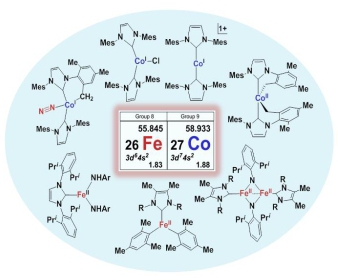Strongly electron-donating ligands, such as N-heterocyclic carbenes (NHCs) and silyl anions, are among the favorite of chemists’ ligand arsenal for their capability of creating electron-rich metal center and stabilizing low-valent transition metal species. Silyl donor-functionalized NHC ligands are such a type of strongly electron-donating ligands having long been sought in the organometallic community. However, because of the intrinsic synthetic challenge of installing a Lewis acidic silane moiety with a strong nucleophilic NHC in a same ligand scaffold, this type of ligands as well as their metal complexes remained elusive. Recently, researchers at Shanghai Institute of Organic Chemistry achieved the first preparation of silyl donor-functionalized NHC ligand scaffolds by employing a sequential cobalt-mediated C-H bond activation and silylation protocol (Angew. Chem. Int. Ed.2013,52, 10845). 
Low-Coordinate Iron- and Cobalt-NHC Complexes (Imaged by Liang Deng@SIOC) The team led by Prof. Liang Deng at Shanghai Institute of Organic Chemistry has been focusing their research on synthetic base metal chemistry with special emphasizing on reactive iron and cobalt complexes capable of activating inert bonds and small molecules. Prior to the aforementioned finding, they have systematically studied the coordination chemistry of monodentate NHCs toward iron and cobalt centers, and achieved the construction of a series of three- and two-coordinate iron and cobalt complexes with NHC ligation. Further reactivity studies proved that the low-coordinate iron and cobalt complexes can serve as useful models for exploring the open-shell organometallic chemistry of iron and cobalt species (Organometallics 2011, 30, 2018; 2011, 30, 4687; 2012, 31, 4537; 2012, 31, 6518; 2012, 31, 7040; Inorg. Chem. 2013, 52, 59). 
Synthetic Protocol for the Silyl-Donor Functionalized NHC-Cobalt Complexes (Imaged by Liang Deng@SIOC)
The team’s continuing exploration on low-coordinate iron- and cobalt-NHC chemistry then led to the meaningful finding of cobalt(0)-mediated C(sp3)-H bond activation reaction, with which they were able to construct an doubly cyclometallated cobalt(II)-NHC compound holding a distorted square planar cobalt(II) center. The construction of the silyl donor-functionalized NHC ligands was ingeniously achieved by the interacting the cyclometallated cobalt(II)-NHC complex with primary or secondary silane. This synthetic protocol, metal-mediated sequential C-H bond activation and silylation, avoids the undesired reaction of silane with NHC, and thus enables the syntheses of the unique silyl donor-functionalized NHC complexes that are difficult to access by other means. As a successful application of the silyl donor-functionalized NHC-cobalt complexes in catalysis, the team has demonstrated that the silyl donor-functionalized NHC-cobalt complexes can effectively catalyze the hydrosilylation of terminal olefin with phenyl silanes with very fast initial rate, high turnover number (up to 15,000), and selectivity, which outperfom those of classical cobalt-carbonyl catalysts (Angew. Chem. Int. Ed. 2013, 52, 10845). This work was supported by National Natural Sciences Foundation of China and National Basic Research Program of China. |


